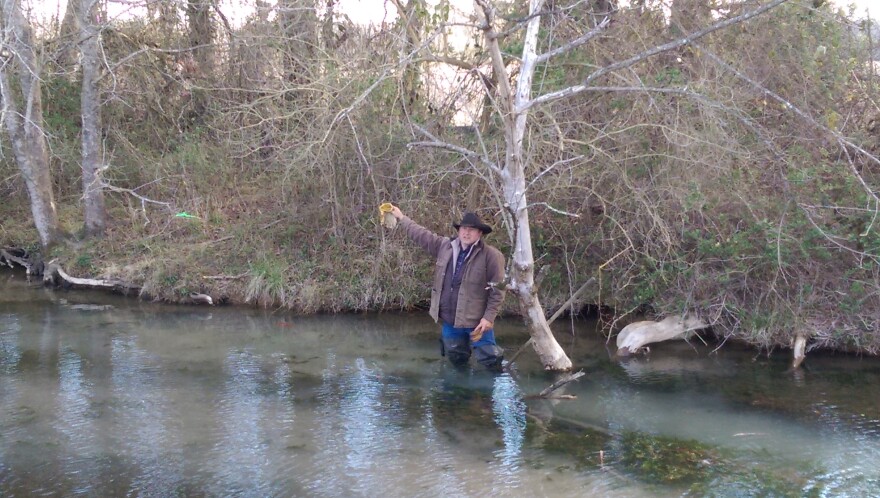NASHVILLE, Tenn. (WMOT) -- It may sound like a throwback to the state’s pioneering days, but there are a growing number of Tennesseans interested in trapping wild animals for their meat and fur.
On a recent Saturday morning, the Tennessee Wildlife Resources Agency and the Tennessee Fur Harvesters Association partnered to put on a trapping seminar. So many people showed up, TWRA personnel had to scramble to find more transportation.
Several dozen aspiring trappers crammed themselves on to a hastily assembled caravan of trucks and hay wagons, and set off for a look at several traps seminar instructors had placed nearby.
Over the next two hours the students were shown traps set at the edge of fields, along game trails, beside river banks and even in a nearby pond. The snares were set for raccoon, possum, fox, coyote, muskrat and beaver to name just a few game animals.
The first trap the students visited was empty, but the second was not. The instructor used a small caliber pistol to put down a trapped possum, and then a raccoon; an act they call “dispatching.” The students were warned they might see this, but no one shies away.
At the next set, participants gather into a tight circle as 20 year old Chris Bradey explains his trapping technique. Bradey explains trappers use the animal’s own instincts against. It. They put down various scents that either arouse the critter’s mating instinct, excite its desire to defend territory, or triggers its fear of a predator.

“If you’ve got a bobcat, I mean they’re not very smart at all,” Bradey explained. “I mean you could put a little piece of flag and it’ll come from a mile across the field just to see what it is. Now a coyote on the other hand, if he comes by something like that he’s gonna’ kind of back up and say ‘What was that?’ and he’s gonna kind a walk around that set a few times before he comeS in. Sometimes they won’t come into a set at all. They’ll just walk off.”
When the caravan headed back to camp for lunch, Master Trapper James Lord took time to talk about his craft. He says he knows of only one Tennessean currently making a living trapping for fur. Lord says most trappers make their money eliminating nuisance animals for landowners.
“You’re gonna’ go on deer leases and turkey hunting clubs and control the population,” he said. “You’re going to take out just about all types of predators that you can to help eliminate most of them, to help the turkeys thrive and the deer and take stress off of those. That’s where you can make a living do that.”

Changing attitudes about wearing fur garments has all but eliminated the fur business in the U.S., but American trappers can still sell their furs to overseas buyers. A fur sale is held annually in Tennessee, but James Lord says trappers don’t get enough to make a living at it. He says most people trap as a hobby or as a sideline, and come from all walks of life.
“Somebody that might have a job that’s real low income, to doctors and lawyers I’ve met that they trap. It’s really amazing at the different range of people that you’ll meet,” Lord said.
Diane Arroyo and Levi Lynn turned out for the seminar. The couple said they’ve always been avid hunters and are conscientious about using every bit of what they kill. They attended the presentation to learn how to cure the hides they bring home.
“It’s kind of lifestyle,” Lynn said. “It’s a holistic view of what you’re doing. You know, sustainability and things like that.”
Farmer Toby Toombs brought his son Tucker to the training class. Mr. Toombs learned to trap as a boy and wants to introduce Tucker to the sport. He doesn’t trap a lot these days, but occasionally gets calls for help from neighbors in the subdivisions that surround his property.

“Beavers don’t care if you build a house. They’ll readily dam up your little pretty creek and flood everything around it. So as farms become subdivisions, that becomes a problem,” Toombs said.
Whatever the reason the trapping demo’s participants turned out, farmer Toombs saw it as a positive development.
“It’s quite refreshing that, you know, especially all the young people you see walking around. Trapping is a dying art, so glad to see people kind of picking up the call and going with it,” Toombs said.
If you’d like to learn about a future trapping demonstrations, browse by the websites for the TWRA or the Tennessee Fur Harvesters Association.


